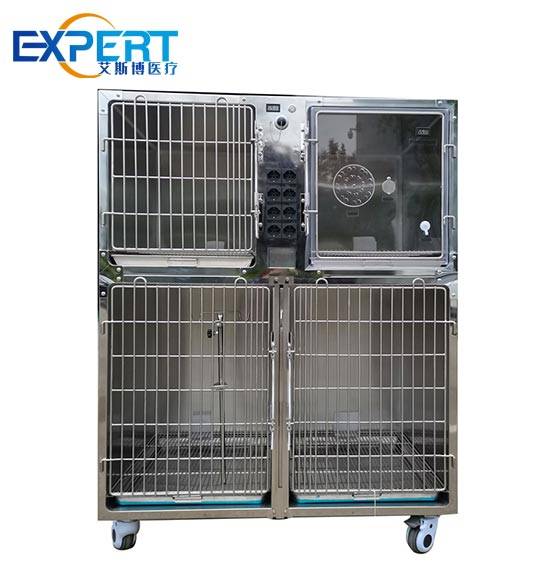عنوان
304 شارع الكاردينال الشمالي
مركز دورتشستر ، ماساتشوستس 02124
ساعات العمل
من الاثنين إلى الجمعة: 7 صباحًا - 7 مساءً
عطلة نهاية الأسبوع: 10 صباحًا - 5 مساءً
مرحباً بكم في مدونتي!
قبل أن نتعمق في المحتوى، أود منك الانضمام إليّ على منصات التواصل الاجتماعي الخاصة بي حيث أشارك المزيد من الأفكار وأتفاعل مع المجتمع وأنشر التحديثات. إليك كيفية التواصل معي:
فيسبوك:https://www.facebook.com/profile.php?id=100071234835011
لينكدإن:https://www.linkedin.com/company/74943205/admin/dashboard/
يوتيوب:www.youtube.com/@shandongexpertmedicalequip4695
تيك توك:www.tiktok.com/@expertmedical
الآن، لنبدأ رحلتنا معًا. أتمنى أن تجد المحتوى هنا مفيدًا وجذابًا وقيمًا.

تلعب أقفاص الأكسجين البيطرية دورًا محوريًا في توفير العلاج بالأكسجين للحيوانات المريضة في العيادات والمستشفيات البيطرية. صُممت هذه الأقفاص المتخصصة لتوفير الأكسجين بمستويات مُتحكم بها مع ضمان راحة الحيوانات وسلامتها. في هذا الدليل الشامل، سنستكشف أهمية أقفاص الأكسجين البيطرية، وخصائص تصميمها، وفوائدها، وكيف تُسهم في رفاهية الحيوانات المريضة.
أقفاص الحيوانات البيطرية، المعروفة أيضًا باسم بيوت الأكسجين أو غرف الأكسجين، هي وحدات مغلقة توفر بيئة مُتحكم بها لتقديم العلاج بالأكسجين للحيوانات. تُصنع هذه الأقفاص عادةً من مواد شفافة مثل الأكريليك أو البولي كربونات لتسهيل مراقبة حالة الحيوان. تتوفر بأحجام متنوعة لتناسب مختلف أنواع وأحجام الحيوانات، بدءًا من الثدييات الصغيرة وصولًا إلى الكلاب والقطط الكبيرة.
تم تجهيز أقفاص الأكسجين البيطرية بالعديد من ميزات التصميم لضمان راحة وسلامة مرضى الحيوانات:
البناء الشفاف:جدران القفص مصنوعة من مواد شفافة للسماح بمراقبة حالة الحيوان بصريًا دون إزعاجه. تم تصميم أرضية القفص لتكون مريحة للحيوان للمشي عليها، مع خيارات الدفء أو التبريد حسب احتياجاته.
تهويةتضمن أنظمة التهوية تدفقًا كافيًا للهواء داخل القفص مع منع تراكم ثاني أكسيد الكربون. قد يؤدي سوء التهوية إلى مشاكل تنفسية وإزعاج للحيوانات. من الضروري تنظيف نظام التهوية وصيانته بانتظام لضمان جودة هواء مثالية لسكان القفص. كما تساعد التهوية الجيدة على تنظيم درجة الحرارة والرطوبة، مما يخلق بيئة صحية ومريحة للحيوانات. المراقبة المنتظمة لأنظمة تدفق الهواء والتهوية ضرورية للوقاية من أي مشاكل تنفسية والحفاظ على صحة الحيوانات.
منافذ الوصولتتيح منافذ الوصول للأطباء البيطريين تقديم العلاجات الطبية ومراقبة العلامات الحيوية للحيوان دون فتح القفص. كما توفر هذه المنافذ طريقة آمنة للتعامل مع الحيوان دون التسبب في إجهاد أو خطر هروب غير ضروري. تضمن هذه الميزة المبتكرة تقديم الرعاية البيطرية بكفاءة وفعالية، مما يعزز صحة الحيوانات ورفاهيتها في بيئة خاضعة للرقابة.
أرضيات مانعة للانزلاقغالبًا ما تكون أرضية القفص مُجهزة بأسطح مانعة للانزلاق لمنع الانزلاق وضمان استقرار الحيوان. يمكن توفير مجموعة متنوعة من مواد الفراش، مثل التبن ونشارة الخشب والورق الممزق، لتوفير الراحة والعزل من برودة الأرضية. من المهم تنظيف الفراش واستبداله بانتظام للحفاظ على بيئة صحية للحيوان. بالإضافة إلى ذلك، قد تتضمن بعض الأقفاص مناطق مخصصة للأكل والشرب واللعب لتعزيز السلوكيات الصحية والصحة العامة. كما أن توفير الألعاب والأنشطة المُثرية يُساعد على منع الملل وتحفيز التحفيز الذهني. بشكل عام، يلعب القفص المُجهز جيدًا دورًا حاسمًا في ضمان سلامة الحيوان وراحته وسعادته.
سهولة التنظيفصُممت أقفاص العيادات البيطرية لسهولة تنظيفها وتعقيمها للحفاظ على بيئة معقمة للحيوانات. كما أنها مُجهزة بمقاييس تدفق الأكسجين ومقاييس الضغط لضمان حصول الحيوانات على مستويات الأكسجين المناسبة. بالإضافة إلى ذلك، صُممت هذه الأقفاص لتوفير مساحة مريحة وآمنة للحيوانات التي تتعافى، مع ميزات مثل الأرفف القابلة للتعديل، ومنافذ الوصول للمراقبة والعلاج، ولوحات الرؤية لسهولة المراقبة.


يقدم استخدام أقفاص الأكسجين البيطرية العديد من الفوائد لمرضى الحيوانات:
تحسين توصيل الأكسجين:توفر أقفاص الأكسجين البيطرية بيئة خاضعة للرقابة لتقديم العلاج بالأكسجين، مما يضمن مستويات الأكسجين المثالية لاحتياجات الجهاز التنفسي للحيوان.
انخفاض التوتر:يساعد التصميم المغلق للأقفاص على تقليل التوتر والقلق لدى المرضى من الحيوانات من خلال توفير بيئة آمنة ومألوفة.
مراقبة مُحسّنة:يستطيع الأطباء البيطريون مراقبة حالة الحيوان واستجابته للعلاج بسهولة من خلال الجدران الشفافة للقفص.
عزل:يمكن استخدام أقفاص الأكسجين البيطرية لعزل الحيوانات المعدية، ومنع انتشار الأمراض المعدية إلى المرضى الآخرين.
راحة:تضمن ميزات تصميم أقفاص الأكسجين البيطرية، مثل الفراش الناعم والأرضيات غير القابلة للانزلاق، راحة الحيوان أثناء العلاج.

| دراسة الحالة | صِنف | حالة | حصيلة |
|---|---|---|---|
| كلب مصاب بالالتهاب الرئوي | الكلاب | ضائقة تنفسية شديدة | الشفاء التام بعد 48 ساعة من العلاج بالأكسجين |
| قطة مصابة بالربو | قطط | تفاقم الربو الحاد | تحسن سريع في الحالة التنفسية خلال ساعات |
| أرنب مصاب بفقر الدم | الأرانب | فقر الدم الانحلالي | تحسن تدريجي في تشبع الأكسجين على مدى عدة أيام |
أقفاص الأكسجين البيطرية تلعب أقفاص الأكسجين البيطرية دورًا حيويًا في علاج وإدارة أمراض الجهاز التنفسي لدى الحيوانات المريضة. من خلال توفير بيئة مُحكمة للعلاج بالأكسجين، تضمن هذه الأقفاص المتخصصة راحة وسلامة ورفاهية الحيوانات الخاضعة للعلاج. إن ميزات تصميم أقفاص الأكسجين البيطرية وفوائدها تجعلها أداة أساسية في الطب البيطري لتقديم رعاية تنفسية فعالة لمجموعة واسعة من الأنواع.
س: هل أقفاص الأكسجين البيطرية مناسبة لجميع أنواع الحيوانات؟
ج: صُممت أقفاص الأكسجين البيطرية لاستيعاب مجموعة واسعة من أنواع الحيوانات، بما في ذلك الكلاب والقطط والأرانب والثدييات الصغيرة. ومع ذلك، قد يختلف حجم القفص وتصميمه باختلاف نوع الحيوان وحجمه.
س: ما هي المدة التي يمكن للحيوانات البقاء فيها في قفص الأكسجين البيطري؟
ج: تعتمد مدة بقاء الحيوان في قفص الأكسجين البيطري على شدة حالته التنفسية ومدى استجابته للعلاج. سيراقب الأطباء البيطريون حالة الحيوان ويعدلون العلاج وفقًا لذلك.
س: هل يمكن استخدام أقفاص الأكسجين البيطرية في الرعاية بعد العمليات الجراحية؟
ج: نعم، يمكن استخدام أقفاص الأكسجين البيطرية للرعاية بعد العمليات الجراحية لتوفير الأكسجين الإضافي ودعم عملية تعافي الحيوان. تساعد بيئة القفص المُتحكم بها على ضمان الشفاء والتعافي الأمثل.
س: كم مرة يجب أن أقفاص الأكسجين البيطرية يتم تنظيفها وتعقيمها؟
ج: يجب تنظيف وتعقيم أقفاص الأكسجين البيطرية بانتظام للحفاظ على بيئة معقمة للحيوانات. يُنصح بالتنظيف والتطهير يوميًا، بالإضافة إلى التنظيف الشامل بين كل مريض لمنع التلوث المتبادل.
س: هل هناك أي مخاطر مرتبطة باستخدام أقفاص الأكسجين البيطرية؟
ج: على الرغم من أن أقفاص الأكسجين البيطرية آمنة وفعالة بشكل عام لتقديم العلاج بالأكسجين للحيوانات المريضة، إلا أن هناك بعض المخاطر المرتبطة باحتجازها لفترات طويلة أو استخدامها بشكل غير صحيح. ينبغي على الأطباء البيطريين مراقبة الحيوانات في أقفاص الأكسجين عن كثب واتخاذ التدابير المناسبة لضمان سلامتها وراحتها.
